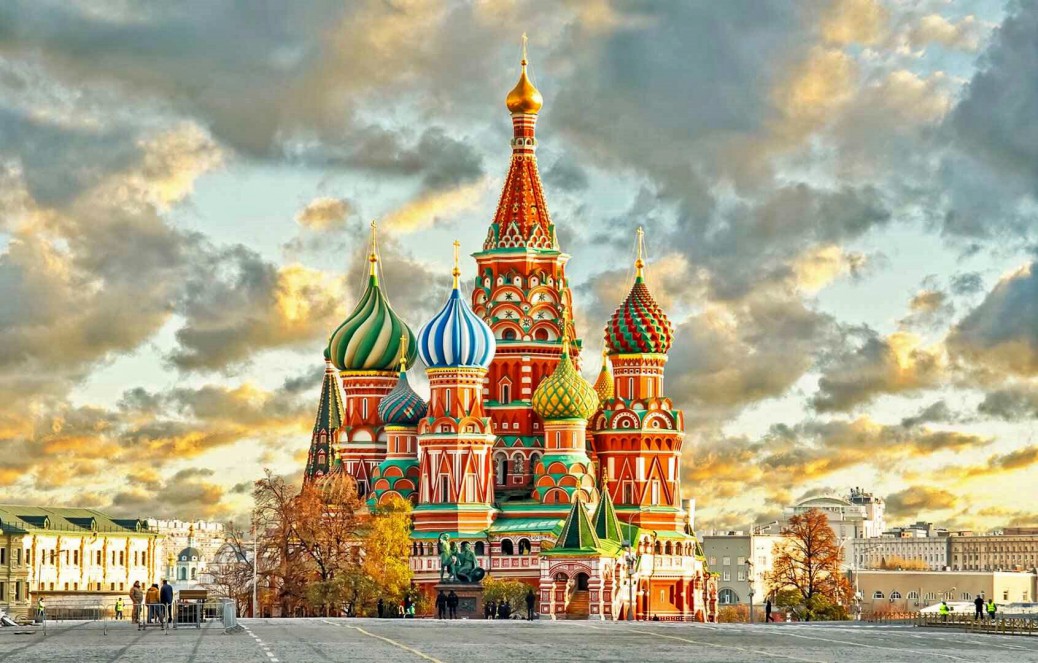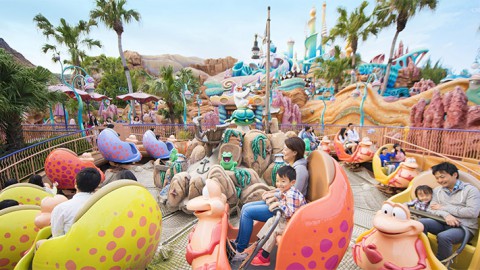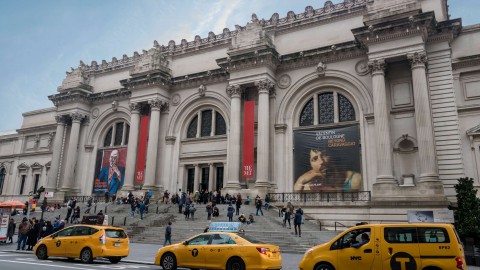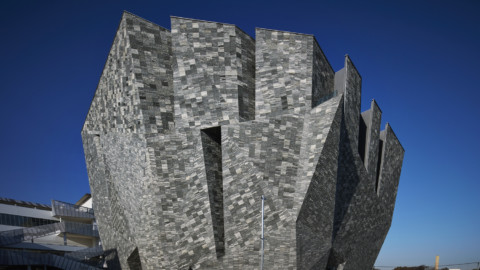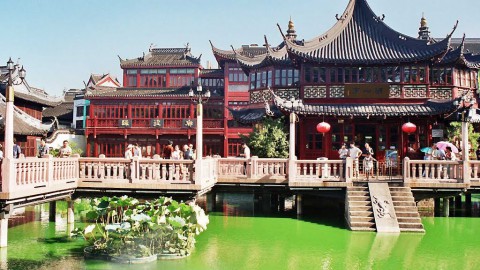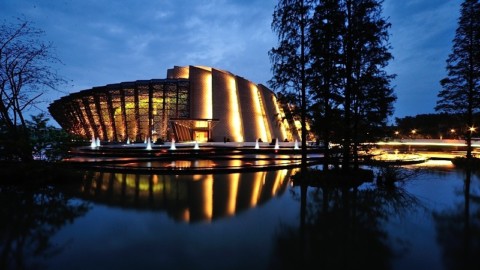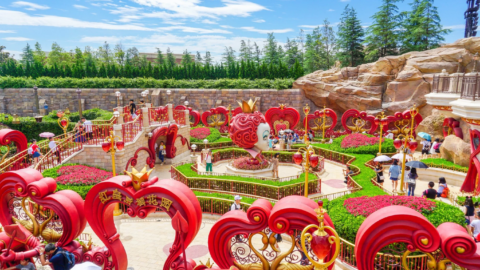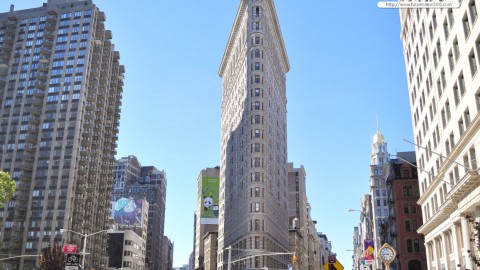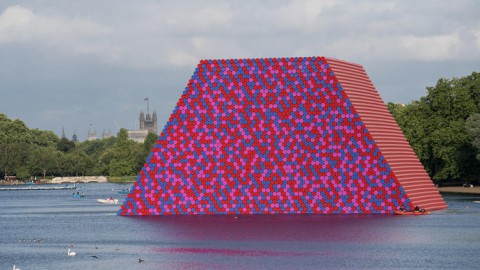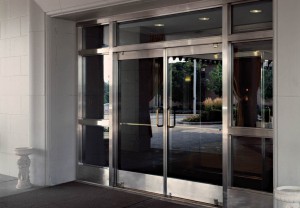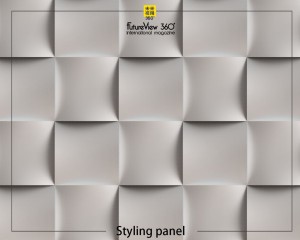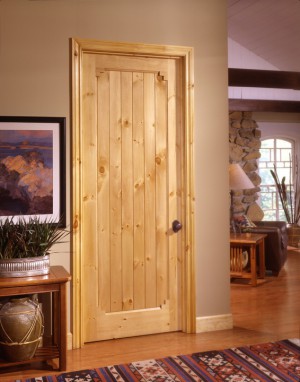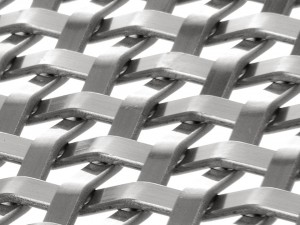Saint Basil’s Cathedral 聖巴西爾大教堂
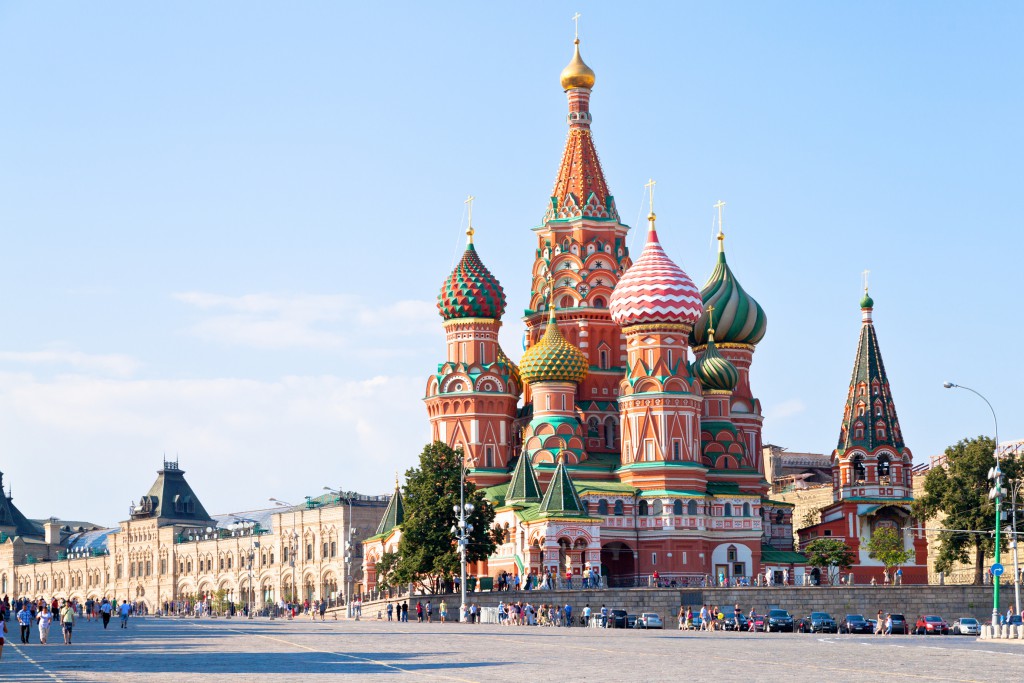
The Cathedral of Vasily the Blessed (Russian: собо́р Васи́лия Блаже́нного, Sobor Vasiliya Blazhennovo), commonly known as Saint Basil’s Cathedral, is a church in Red Square in Moscow, Russia and is one of the most recognizable symbols of the country. The building, now a museum, is officially known as the Cathedral of the Intercession of the Most Holy Theotokos on the Moat (Собо́р Покрова́ Пресвято́й Богоро́дицы, что на Рву, Sobor Pokrova Presvyatoy Bogoroditsy, chto na Rvu) or Pokrovsky Cathedral (Покро́вский собо́р). It was built from 1555–1561 on orders from Ivan the Terrible and commemorates the capture of Kazan and Astrakhan. It was the city’s tallest building until the completion of the Ivan the Great Bell Tower in 1600. The Saint Basil’s Cathedral is not to be confused with the Moscow Kremlin.
The original building, known as Trinity Church and later Trinity Cathedral, contained eight churches arranged around a ninth, central church of Intercession; a tenth church was erected in 1588 over the grave of venerated local saint Vasily (Basil). In the 16th and 17th centuries, the church, perceived (as with all churches in Byzantine Christianity) as the earthly symbol of the Heavenly City, was popularly known as the “Jerusalem” and served as an allegory of the Jerusalem Temple in the annual Palm Sunday parade attended by the Patriarch of Moscow and the tsar.
The building is shaped like the flame of a bonfire rising into the sky, a design that has no parallel in Russian architecture. Dmitry Shvidkovsky, in his book Russian Architecture and the West, states that “it is like no other Russian building. Nothing similar can be found in the entire millennium of Byzantine tradition from the fifth to the fifteenth century … a strangeness that astonishes by its unexpectedness, complexity and dazzling interleaving of the manifold details of its design.” The cathedral foreshadowed the climax of Russian national architecture in the 17th century.
As part of the program of state atheism, the church was confiscated from the Russian Orthodox community as part of the Soviet Union’s anti-theist campaigns and has operated as a division of the State Historical Museum since 1928. It was completely secularized in 1929 and remains a federal property of the Russian Federation. The church has been part of the Moscow Kremlin and Red Square UNESCO World Heritage Site since 1990. It is not actually within the Kremlin, but often served as a visual metonym for Russia in western media throughout the Cold War and to the modern day.
瓦西里大教堂(俄語:соборВасилияБлаженного,Sobor Vasiliya Blazhennovo),俗稱聖巴西爾大教堂,是俄羅斯莫斯科紅場的教堂,也是該國最知名的象徵之一。該建築現在是一座博物館,正式被稱為護城河上最神聖的聖母代禱大教堂(СоборПокроваПресвятойБогородицы,чтонаРву,Sobor Pokrova Presvyatoy Bogoroditsy,chto na Rvu)或Pokrovsky Cathedral(Покровскийсобор) 。它是根據伊凡雷帝的命令於1555年至1951年建造的,以紀念喀山和阿斯特拉罕的捕獲。它是該城市最高的建築,直到1600年伊凡大鐘樓完工。聖巴西爾大教堂不要與莫斯科克里姆林宮相混淆。
原來的建築被稱為三一教堂(Trinity Church)和後來的三一大教堂(Trinity Cathedral),其中包括八座教堂,這些教堂圍繞著代禱的第九中央教堂而安排; 1588年,在尊敬的當地聖瓦西里(巴茲爾)的墳墓上建起了第十座教堂。在16和17世紀,教會被認為(與拜占庭基督教的所有教會一樣)是天堂城市的地球象徵,俗稱“耶路撒冷”,並在每年的棕櫚樹中作為耶路撒冷聖殿的寓言。星期天遊行由莫斯科主教和沙皇出席。
這座建築的形狀像篝火升起的火焰,這種設計與俄羅斯建築並不相似。德米特里·施維德科夫斯基(Dmitry Shvidkovsky)在他的著作“俄羅斯建築與西方”(Russian Architecture and the West)中指出,“它就像沒有其他俄羅斯建築一樣。在五世紀至十五世紀的拜占庭傳統的整個千年中,沒有任何類似的東西可以找到……一種令人驚訝的陌生感它的意外,複雜和令人眼花繚亂的交錯細節設計。“大教堂預示著17世紀俄羅斯民族建築的高潮。
作為國家無神論綱領的一部分,教會被俄羅斯東正教社區沒收,作為蘇聯反恐運動的一部分,自1928年以來一直作為國家歷史博物館的一個部門運作。它在1929年完全世俗化並且仍然存在俄羅斯聯邦的聯邦財產。該教堂自1990年以來一直是莫斯科克里姆林宮和紅十字會聯合國教科文組織世界遺產的一部分。它實際上並不在克里姆林宮內,而是在整個冷戰期間和現代的西方媒體中經常作為俄羅斯的視覺轉喻。
Religion
Affiliation:Russian Orthodox
Ecclesiastical or organizational status:State Historical Museum with occasional church services since 1991
Year consecrated :12 July 1561
Status:Active
Location
Location:Red Square, Moscow, Russia
Geographic coordinates:55°45′9″N 37°37′23″ECoordinates: 55°45′9″N 37°37′23″E
Architecture
Architect(s):Barma and Postnik Yakovlev
Architectural type:Church
Groundbreaking:1555
Specifications
Height (max):47.5 metres (156 ft)
Dome(s):10
Dome height (inner):ff
Spire(s):2
UNESCO World Heritage Site
Official name: Kremlin and Red Square, Moscow
Type:Cultural
Criteria:i, ii, iv, vi
Designated:1990
Reference no.:545
State Party:Russia
Region:Europe and North America
Session:14th
宗教
隸屬:俄羅斯東正教
教會或組織地位:自1991年以來偶爾提供教堂服務的國家歷史博物館
奉獻年份:1561年7月12日
狀態:活動
地點
地點:紅場,莫斯科,俄羅斯
地理坐標:55°45’9“N 37°37’23”ECoordinates:55°45’9“N 37°37’23”E
建築
建築師:巴馬和Postnik Yakovlev
建築類型:教堂
開工:1555
產品規格
高度(最大):47.5米(156英尺)
圓頂(S):10
圓頂高度(內部):ff
尖頂(S):2
聯合國教科文組織世界遺產
官方名稱:莫斯科克里姆林宮和紅場
類型:文化
標準:i,ii,iv,vi
指定:1990
參考編號:545
締約國:俄羅斯
地區:歐洲和北美
會議:14
The site of the church had been, historically, a busy marketplace between the St. Frol’s (later Saviour’s) Gate of the Moscow Kremlin and the outlying posad. The centre of the marketplace was marked by the Trinity Church, built of the same white stone as the Kremlin of Dmitry Donskoy (1366–68) and its cathedrals. Tsar Ivan IV marked every victory of the Russo-Kazan War by erecting a wooden memorial church next to the walls of Trinity Church; by the end of his Astrakhan campaign, it was shrouded within a cluster of seven wooden churches. According to the report in Nikon’s Chronicle, in the autumn of 1554 Ivan ordered the construction of the wooden Church of Intercession on the same site, “on the moat”. One year later, Ivan ordered the construction of a new stone cathedral on the site of Trinity Church to commemorate his campaigns. Dedication of a church to a military victory was “a major innovation” for Muscovy. The placement of the church outside the Kremlin walls was a political statement in favor of posad commoners and against hereditary boyars.
Contemporary commentators clearly identified the new building as Trinity Church, after its easternmost sanctuary; the status of “katholikon” (собор, sobor, large assembly church) had not been bestowed on it yet:
On the Trinity on the Moat in Moscow.
In the same year, through the will of czar and lord and grand prince Ivan began making the pledged church, as he promised for the capture of Kazan: Trinity and Intercession and seven sanctuaries, also called “on the moat”. And the builder was Barma with company.
— Piskaryov Chronicle, 1560 (7068 per Byzantine calendar)
The identity of the architect is unknown. Tradition held that the church was built by two architects, Barma and Postnik: the official Russian cultural heritage register lists “Barma and Postnik Yakovlev”. Researchers proposed that both names refer to the same person, Postnik Yakovlev or, alternatively, Ivan Yakovlevich Barma (Varfolomey). Legend held that Ivan blinded the architect so that he could not re-create the masterpiece elsewhere, Many historians are convinced that it is a myth, as the architect later participated in the construction of the Cathedral of the Annunciation in Moscow as well as in building the walls and towers of the Kazan Kremlin. Postnik Yakovlev remained active at least throughout the 1560s.
There is evidence that construction involved stonemasons from Pskov and German lands.
從歷史上看,教堂遺址一直是莫斯科克里姆林宮的St. Frol(後來的救世主)大門和外圍的地方之間的繁忙市場。市中心的標誌是三位一體教堂,由與德米特里·頓斯科伊克里姆林宮(1366-68)及其大教堂相同的白色石頭建造而成。沙皇伊凡四世在三一教堂的城牆旁豎立了一座木製紀念教堂,標誌著俄羅斯 – 喀山戰爭的每一次勝利;在阿斯特拉罕戰役結束時,它被七座木製教堂所籠罩。根據尼康紀事報的報導,在1554年秋天,伊万下令在同一地點建造木製代禱教堂,“在護城河上”。一年後,伊万下令在三一教堂的遺址上建造一座新的石頭大教堂,以紀念他的競選活動。致力於教會獲得軍事勝利是莫斯科的“重大創新”。教堂在克里姆林宮城牆外的位置是一個政治聲明,支持普通人和世襲男爵。
當代評論家清楚地將新建築物確定為三一教堂(Trinity Church),位於其最東端的避難所之後;尚未授予“katholikon”(собор,sobor,大會教堂)的地位:
論莫斯科護城河的三位一體。
同年,通過沙皇,領主和大王子的意願,伊万開始建立承諾的教會,因為他承諾捕獲喀山:三位一體和代禱和七個庇護所,也被稱為“護城河”。建築師是巴馬公司。
– Piskaryov Chronicle,1560(拜占庭日曆7068)
建築師的身份是未知的。傳統認為教堂是由兩位建築師巴馬和波斯尼克建造的:俄羅斯官方文化遺產登記冊中列有“巴馬和Postnik雅科夫列夫”。研究人員提出,兩個名字都指的是同一個人,Postnik Yakovlev,或者Ivan Yakovlevich Barma(Varfolomey)。傳說認為伊万對建築師不知情,以至於無法在其他地方重新創造傑作。許多歷史學家都相信這是一個神話,因為建築師後來參與了莫斯科的天使報喜大教堂的建設以及建築喀山克里姆林宮的城牆和塔樓。 Postnik Yakovlev至少在整個1560年代保持活躍。
有證據表明建築涉及來自普斯科夫和德國土地的石匠。
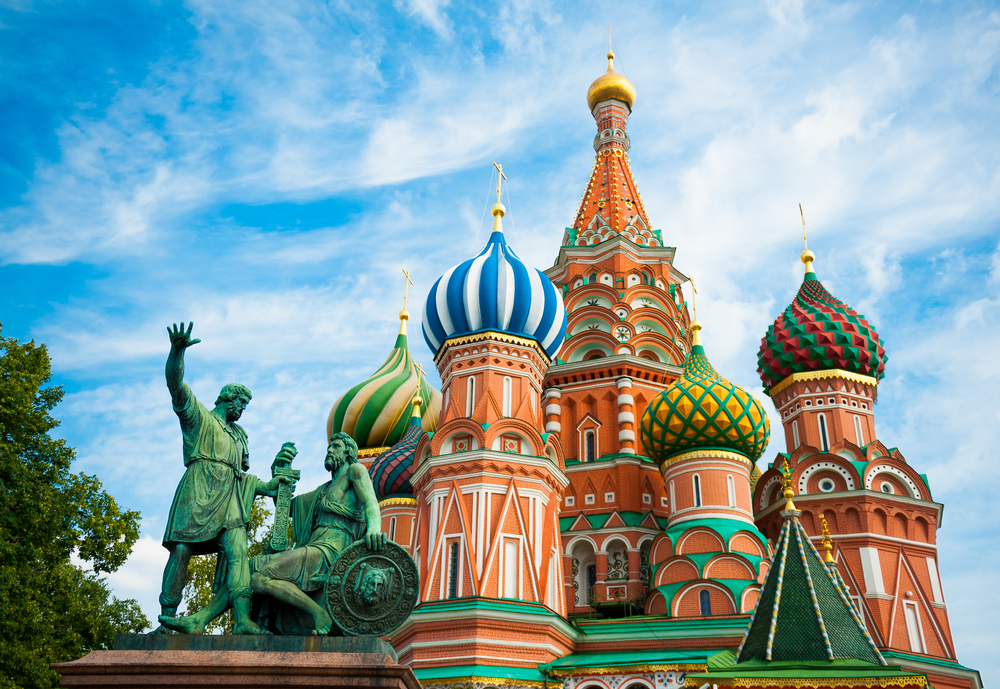
Architectural style
Because the church has no analogue—in preceding, contemporary, or later architecture of Muscovy and Byzantine cultural tradition in general—the sources that inspired Barma and Postnik are disputed. Eugène Viollet-le-Duc rejected European roots for the cathedral, opining that its corbel arches were Byzantine and ultimately Asian. A modern “Asian” hypothesis considers the cathedral a recreation of Qolşärif Mosque, which was destroyed by Russian troops after the siege of Kazan.
Nineteenth-century Russian writers, starting with Ivan Zabelin, emphasized the influence of the vernacular wooden churches of the Russian North; their motifs made their ways into masonry, particularly the votive churches that did not need to house substantial congregations. David Watkin also wrote of a blend of Russian and Byzantine roots, calling the cathedral “the climax” of Russian vernacular wooden architecture.
The church combines the staggered layered design of the earliest (1505–08) part of the Ivan the Great Bell Tower, the central tent of the Church of Ascension in Kolomenskoye (1530s), and the cylindric shape of the Church of Beheading of John the Baptist in Dyakovo (1547);[29] but the origin of these unique buildings is equally debated. The Church in Kolomenskoye, according to Sergei Podyapolsky, was built by Italian Petrok Maly, although mainstream history has not yet accepted his opinion. Andrey Batalov revised the year of completion of Dyakovo church from 1547 to the 1560s–70s, and noted that Trinity Church could have had no tangible predecessors at all.
Dmitry Shvidkovsky suggested that the “improbable” shapes of the Intercession Church and the Church of Ascension in Kolomenskoye manifested an emerging national renaissance, blending earlier Muscovite elements with the influence of Italian Renaissance. A large group of Italian architects and craftsmen continuously worked in Moscow in 1474–1539, as well as Greek refugees who arrived in the city after the fall of Constantinople. These two groups, according to Shvidkovsky, helped Moscow rulers in forging the doctrine of Third Rome, which in turn promoted assimilation of contemporary Greek and Italian culture. Shvidkovsky noted the resemblance of the cathedral’s floorplan to Italian concepts by Antonio da Sangallo the Younger and Donato Bramante, but most likely Filarete’s Trattato di architettura. Other Russian researchers noted a resemblance to sketches by Leonardo da Vinci, although he could not have been known in Ivan’s Moscow. Nikolay Brunov recognized the influence of these prototypes but not their significance; he suggested that mid-16th century Moscow already had local architects trained in Italian tradition, architectural drawing and perspective, and that this culture was lost during the Time of Troubles.
Andrey Batalov wrote that judging by the number of novel elements introduced with Trinity Church, it was most likely built by German craftsmen. Batalov and Shvidkovsky noted that during Ivan’s reign, Germans and Englishmen replaced Italians, although German influence peaked later during the reign of Mikhail Romanov.German influence is indirectly supported by the rusticated pilasters of the central church, a feature more common in contemporary Northern Europe than in Italy.
The 1983 academic edition of Monuments of Architecture in Moscow takes the middle ground: the church is, most likely, a product of the complex interaction of distinct Russian traditions of wooden and stone architecture, with some elements borrowed from the works of Italians in Moscow. Specifically, the style of brickwork in the vaults is Italian.
建築風格
因為教會在前面,當代或後來的莫斯科和拜占庭文化傳統的建築中沒有類似的東西 – 啟發巴馬和Postnik的來源是有爭議的。 EugèneViollet-le-Duc拒絕歐洲大教堂的根源,認為它的牛腿拱門是拜占庭式的,最終是亞洲人。一個現代的“亞洲”假設認為大教堂是Qolşärif清真寺的娛樂場所,在喀山圍困後被俄羅斯軍隊摧毀。
十九世紀的俄羅斯作家,從伊万·扎貝林開始,強調了俄羅斯北方白話木製教堂的影響;他們的主題進入磚石結構,特別是那些不需要容納大量教會的奉獻教會。大衛·沃特金(David Watkin)也寫了俄羅斯和拜占庭根源的混合,稱大教堂是俄羅斯鄉土木結構的“高潮”。
教堂結合了伊万大鐘樓最早(1505-08)部分的交錯分層設計,在Kolomenskoye(1530年代)的升天教堂的中央帳篷,以及約翰的斬首教堂的圓柱形狀。 Dyakovo的浸信會(1547年); [29]但這些獨特建築的起源同樣存在爭議。根據Sergei Podyapolsky的說法,Kolomenskoye的教堂由意大利人Petrok Maly建造,儘管主流歷史尚未接受他的觀點。安德烈·巴塔洛夫(Andrey Batalov)將Dyakovo教堂的建成年份從1547年改為1560年代至70年代,並指出三位一體教會根本沒有任何有形的前輩。
德米特里·施維德科夫斯基(Dmitry Shvidkovsky)認為,代禱教堂和升天教堂(Kolomenskoye)的“不可能”形狀體現了新興的民族文藝復興,將早期的莫斯科元素與意大利文藝復興的影響融為一體。 1474年至1539年,一大批意大利建築師和工匠在莫斯科不斷工作,以及在君士坦丁堡淪陷後抵達該市的希臘難民。根據施維德科夫斯基的說法,這兩個團體幫助莫斯科統治者建立了第三羅馬的教義,這反過來促進了當代希臘和意大利文化的同化。 Shvidkovsky注意到大教堂的平面圖與Antonio da Sangallo the Younger和Donato Bramante的意大利概念相似,但很可能是Filarete的Trattato di architettura。其他俄羅斯研究人員注意到列奧納多達芬奇與草圖的相似之處,儘管在伊万的莫斯科中他不可能知道。尼古拉·布魯諾夫認識到這些原型的影響,但沒有意義;他認為,16世紀中期莫斯科已有當地建築師接受過意大利傳統,建築繪畫和視角方面的培訓,並且這種文化在“麻煩時期”中消失了。
安德烈·巴塔洛夫(Andrey Batalov)寫道,從三一教堂(Trinity Church)引入的新元素數量來看,它很可能是由德國工匠建造的。巴塔洛夫和施維德科夫斯基指出,在伊万統治時期,德國人和英國人取代了意大利人,儘管德國人的影響在米哈伊爾·羅曼諾夫統治時期達到頂峰。德國的影響力由中央教堂的鄉村壁柱間接支持,這一特徵在當代北歐比在意大利更為常見。
1983年莫斯科建築紀念碑的學術版佔據了中間地帶:教堂很可能是俄羅斯獨特的木製和石製建築傳統的複雜互動的產物,其中一些元素借鑒了莫斯科意大利人的作品。具體來說,金庫中的磚砌風格是意大利風格。
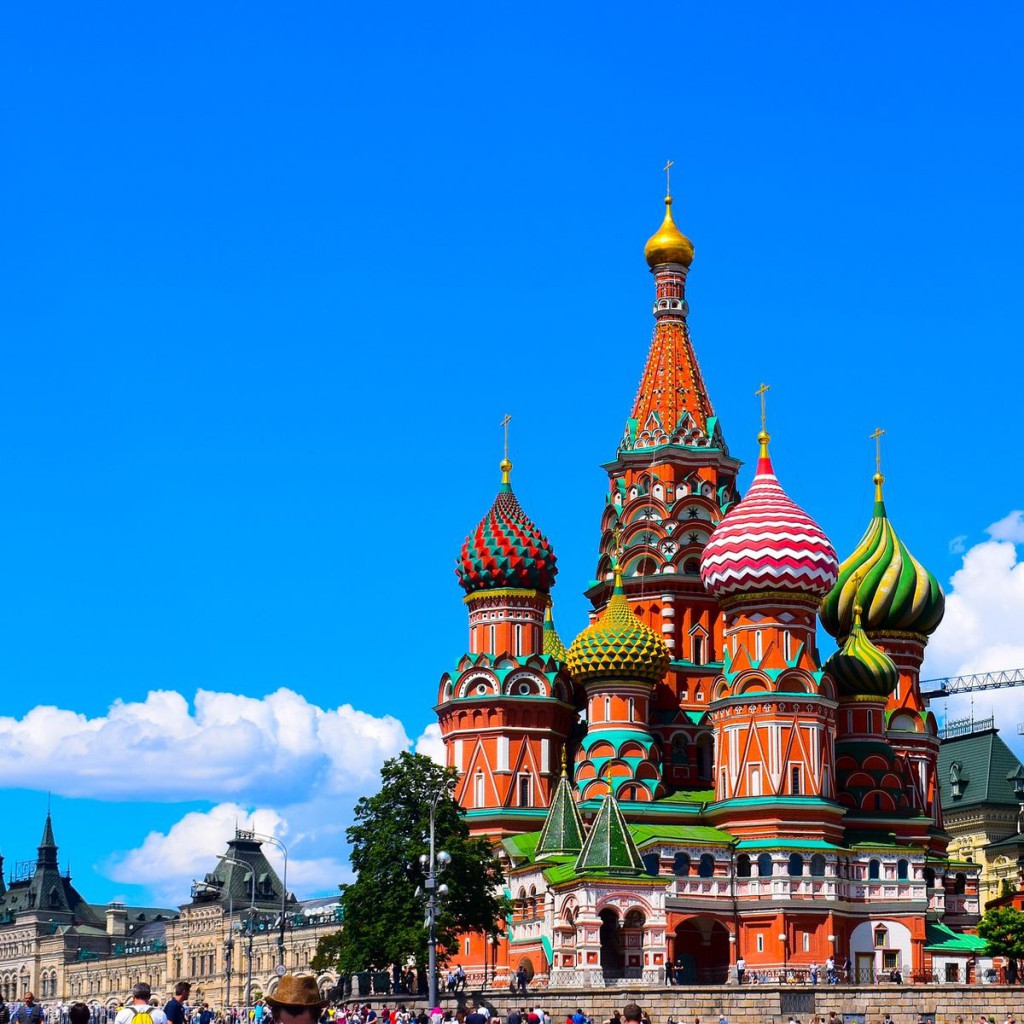
Layout
Instead of following the original ad hoc layout (seven churches around the central core), Ivan’s architects opted for a more symmetrical floor plan with eight side churches around the core,producing “a thoroughly coherent, logical plan” despite the erroneous latter “notion of a structure devoid of restraint or reason” influenced by the memory of Ivan’s irrational atrocities. The central core and the four larger churches placed on the four major compass points are octagonal; the four diagonally placed smaller churches are cuboid, although their shape is barely visible through later additions. The larger churches stand on massive foundations, while the smaller ones were each placed on a raised platform, as if hovering above ground.
Although the side churches are arranged in perfect symmetry, the cathedral as a whole is not. The larger central church was deliberately offset to the west from the geometric center of the side churches, to accommodate its larger apse on the eastern side. As a result of this subtle calculated asymmetry, viewing from the north and the south presents a complex multi-axial shape, while the western facade, facing the Kremlin, appears properly symmetrical and monolithic. The latter perception is reinforced by the fortress-style machicolation and corbeled cornice of the western Church of Entry into Jerusalem, mirroring the real fortifications of the Kremlin.
Inside the composite church is a labyrinth of narrow vaulted corridors and vertical cylinders of the churches. Today the cathedral consists of nine individual chapels. The largest, central one, the Church of the Intercession, is 46 metres (151 ft) tall internally but has a floor area of only 64 square metres (690 sq ft). Nevertheless, it is wider and airier than the church in Kolomenskoye with its exceptionally thick walls. The corridors functioned as internal parvises; the western corridor, adorned with a unique flat caissoned ceiling, doubled as the narthex.
The detached belfry of the original Trinity Church stood southwest or south of the main structure. Late 16th and early 17th century plans depict a simple structure with three roof tents, most likely covered with sheet metal. No buildings of this type survive to date, although it was then common and used in all of the pass-through towers of Skorodom.August von Meyerberg’s panorama (1661) presents a different building, with a cluster of small onion domes.
佈局
Ivan的建築師沒有遵循原始的臨時佈局(圍繞中央核心的七個教堂),而是選擇了一個更加對稱的平面圖,在核心周圍有八個側面教堂,儘管後面的錯誤概念產生了“一個完全連貫,合乎邏輯的計劃”。一種沒有克製或理由的結構“受到伊万非理性暴行記憶的影響。中央核心和放置在四個主要羅盤點上的四個較大的教堂是八角形的;四個對角放置的較小的教堂是長方體,雖然它們的形狀通過後來的添加幾乎看不到。較大的教堂矗立在巨大的地基上,而較小的教堂則分別放在升高的平台上,彷彿盤旋在地面上。
雖然側面教堂的佈局完美對稱,但整個大教堂並非如此。較大的中央教堂故意從側面教堂的幾何中心向西偏移,以容納東側較大的後殿。由於這種微妙的計算不對稱性,從北方和南方觀察呈現出複雜的多軸形狀,而面向克里姆林宮的西立面呈現出恰當的對稱和整體。西方進入耶路撒冷教堂的堡壘式機械化和標記的簷口加強了後者的感知,反映了克里姆林宮的真正防禦工事。
在復合教堂內部是一個迷宮般的狹窄拱形走廊和教堂的垂直圓柱體。今天,大教堂由九個獨立的小教堂組成。最大的中央教堂,代禱教堂,內部高46米(151英尺),但建築面積僅64平方米(690平方英尺)。然而,它比Kolomenskoye的教堂更寬敞,更寬敞,牆壁非常厚。走廊作為內部人員;西部走廊,裝飾著獨特的平坦的天花板,是narthex的兩倍。
原始三一教堂的獨立鐘樓位於主體結構的西南或南部。 16世紀末和17世紀初的計劃描繪了一個簡單的結構,有三個屋頂帳篷,很可能是用金屬板覆蓋。迄今為止,這種類型的建築物都沒有存在,儘管它在Skorodom的所有通道塔中都是常見的.August von Meyerberg的全景(1661年)展示了一個不同的建築,有一簇小洋蔥圓頂。
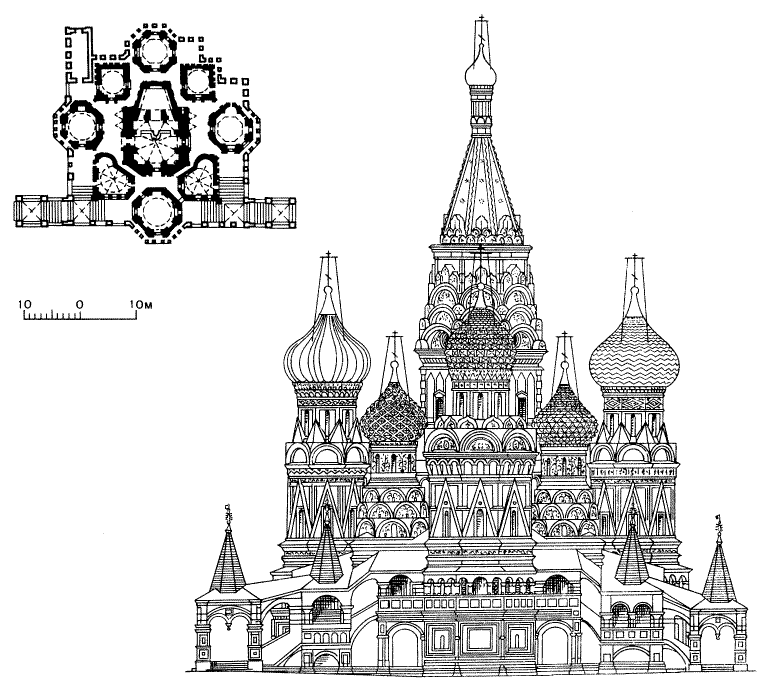
Structure
The foundations, as was traditional in medieval Moscow, were built of white stone, while the churches themselves were built of red brick (28 by 14 by 8 cm (11.0 by 5.5 by 3.1 in)), then a relatively new material (the first attested brick building in Moscow, the new Kremlin Wall, was started in 1485). Surveys of the structure show that the basement level is perfectly aligned, indicating use of professional drawing and measurement, but each subsequent level becomes less and less regular. Restorers who replaced parts of the brickwork in 1954–55 discovered that the massive brick walls conceal an internal wooden frame running the entire height of the church. This frame, made of elaborately tied thin studs, was erected as a life-size spatial model of the future cathedral and was then gradually enclosed in solid masonry.
The builders, fascinated by the flexibility of the new technology, used brick as a decorative medium both inside and out, leaving as much brickwork open as possible; when location required the use of stone walls, it was decorated with a brickwork pattern painted over stucco. A major novelty introduced by the church was the use of strictly “architectural” means of exterior decoration. Sculpture and sacred symbols employed by earlier Russian architecture are completely missing; floral ornaments are a later addition. Instead, the church boasts a diversity of three-dimensional architectural elements executed in brick.
結構體
在中世紀的莫斯科,傳統的基礎是用白色石頭建造的,而教堂本身是用紅磚建造的(28×14×8厘米(11.0乘5.5乘3.1英寸)),然後是一種相對較新的材料(第一個)在莫斯科,新的克里姆林宮牆,證明了磚建築,始於1485年。對結構的調查表明,地下室水平完全對齊,表明使用專業繪圖和測量,但每個後續級別變得越來越不規則。 1954年至1955年更換了磚砌部分的修復工人發現,巨大的磚牆隱藏著一個貫穿整個教堂高度的內部木製框架。這個框架由精心打結的薄鉚釘製成,被豎立為未來大教堂的真人大小的空間模型,然後逐漸被堅固的磚石砌成。
建築商對新技術的靈活性著迷,在內部和外部使用磚作為裝飾性介質,盡可能多地打開磚砌;當位置需要使用石牆時,它用灰泥上的磚牆圖案裝飾。教會引入的一個主要新奇是使用嚴格的“建築”外部裝飾手段。早期俄羅斯建築所採用的雕塑和神聖符號完全缺失;花飾是後來的補充。相反,教堂擁有多種用磚塊砌成的三維建築元素。
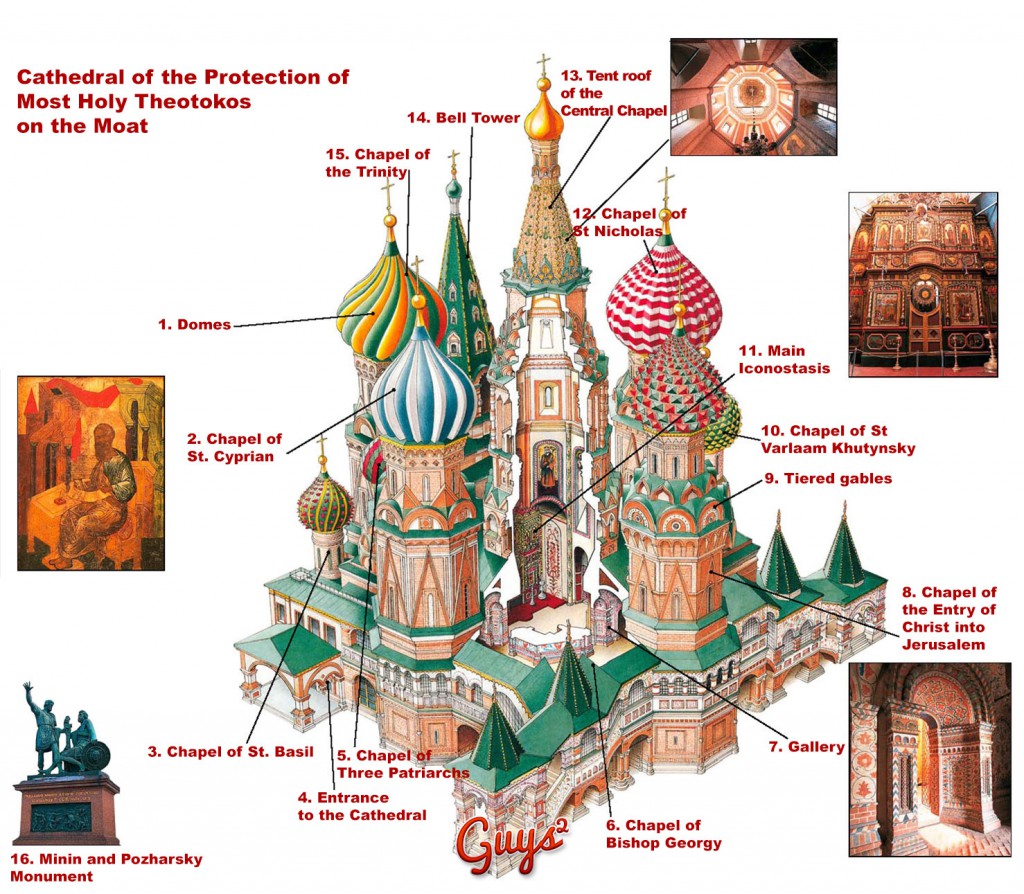
Color
The church acquired its present-day vivid colors in several stages from the 1680s to 1848. Russian attitude towards color in the 17th century changed in favor of bright colors; icon and mural art experienced an explosive growth in the number of available paints, dyes and their combinations. The original color scheme, missing these innovations, was far less challenging. It followed the depiction of the Heavenly City in the Book of Revelation:
And he that sat was to look upon like a jasper and a sardine stone: and there was a rainbow round about the throne, in sight like unto an emerald.
And round about the throne were four and twenty seats: and upon the seats, I saw four and twenty elders sitting, clothed in white raiment; and they had on their heads crowns of gold.
The 25 seats from the biblical reference are alluded to in the building’s structure, with the addition of eight small onion domes around the central tent, four around the western side church and four elsewhere. This arrangement survived through most of the 17th century. The walls of the church mixed bare red brickwork or painted imitation of bricks with white ornaments, in roughly equal proportion. The domes, covered with tin, were uniformly gilded, creating an overall bright but fairly traditional combination of white, red and golden colors. Moderate use of green and blue ceramic inserts provided a touch of rainbow as prescribed by the Bible.
While historians agree on the color of the 16th-century domes, their shape is disputed. Boris Eding wrote that they most likely were of the same onion shape as the present-day domes. However, both Kolomenskoye and Dyakovo churches have flattened hemispherical domes, and the same type could have been used by Barma and Postnik.
顏色
從1680年代到1848年,教堂在幾個階段獲得了現代生動的色彩。17世紀俄羅斯對色彩的態度改變了,有利於鮮豔的色彩;圖標和壁畫藝術在可用塗料,染料及其組合的數量方面經歷了爆炸式增長。缺少這些創新的原始配色方案遠沒有那麼具有挑戰性。它遵循了“啟示錄”中對天堂城市的描述:
那坐著的人就像是一個碧玉和一塊沙丁魚的石頭。寶座周圍有一道彩虹,就像祖母綠一樣。
在寶座周圍有四個和二十個座位。在座位上,我看到四十二位長老坐著,穿著白色衣服;他們頭上戴著金幣。
建築物結構中提到了聖經參考的25個座位,中央帳篷周圍增加了8個小洋蔥圓頂,西側教堂附近有4個,另外4個位於其他地方。這種安排在17世紀的大部分時間裡都存在。教堂的牆壁混合著赤裸的紅磚或用白色裝飾的磚塊模仿,大致相等的比例。圓頂覆蓋著錫,均勻鍍金,營造出整體明亮但相當傳統的白色,紅色和金色組合。適度使用綠色和藍色陶瓷插入物提供了聖經規定的彩虹色。
雖然歷史學家同意16世紀圓頂的顏色,但它們的形狀存在爭議。鮑里斯·艾丁寫道,他們很可能與現今的圓頂形狀相同。然而,Kolomenskoye和Dyakovo教堂都有扁平的半球形圓頂,巴馬和Postnik也可以使用相同的類型。
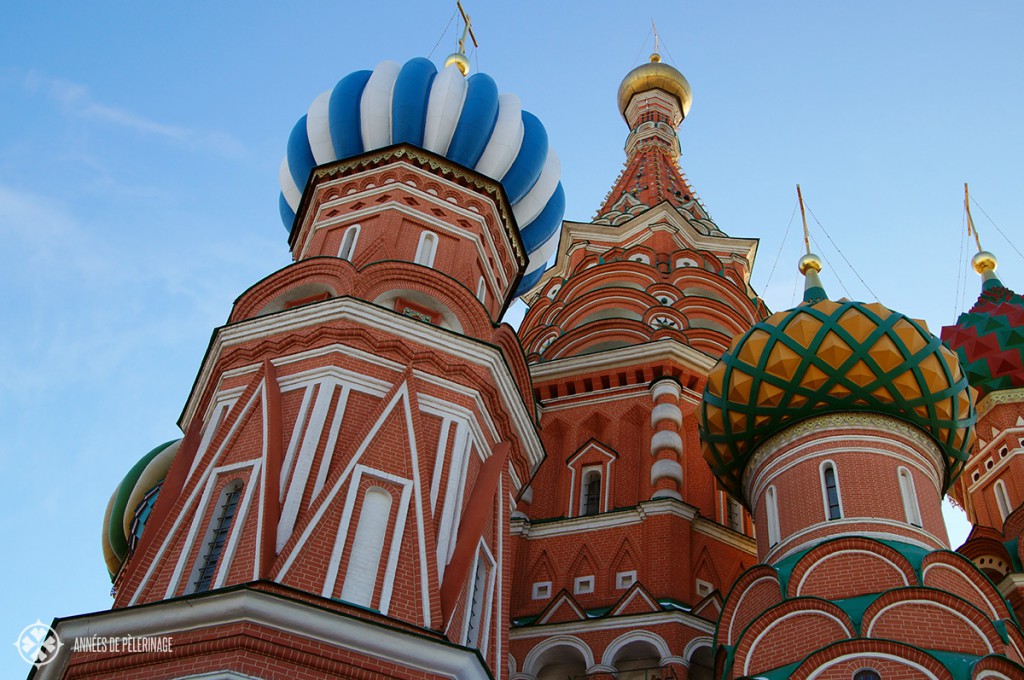
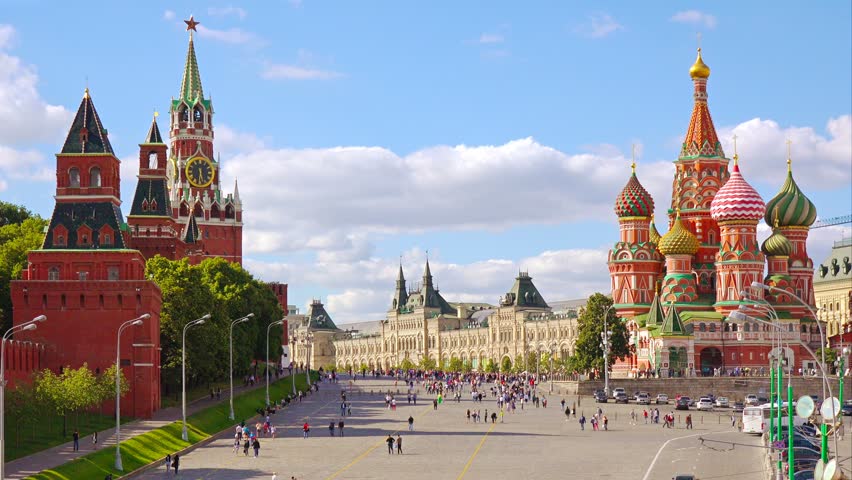
FROM:https://en.wikipedia.org/wiki/Saint_Basil%27s_Cathedral
FROM:Inside St. Basil’s Cathedral in Moscow’s Red Square
FROM:Saint Basil Cathedral in Moscow, Russia, 2012
Don’t you think it’s addictive?
Want to know more about the beauty of architecture?
Come and join our members to explore the beauty of architectural design.
覺得看得不過癮嗎?
想要知道更多建築之美嗎?
快來加入我們的會員,一同探索建築設計之美。
The above article is purely for appreciation and sharing purposes, as well as the construction of new technology and the public can be in-depth understanding of the information at the same time there are sources, will be able to query, no use of the document as a commercial transaction, if illegal, please inform the We will immediately remove the site, thank you for cooperation.
以上文章純粹作為欣賞及分享用途,以及將建築新型技術傳遞給與大眾能夠深入了解,同時資料還有來源,將可查詢,絕無使用該文件資料作為商業交易行為,如有違法請務必告知該網站我們將立即處理撤除,謝謝合作。

